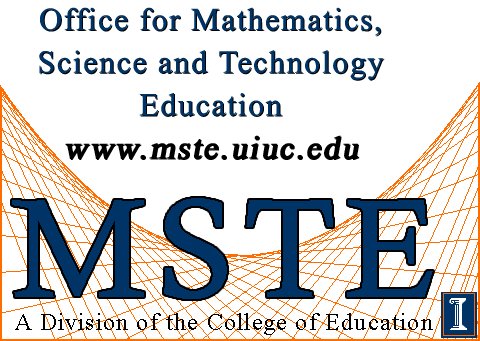Connections to Standards
-
Connections to NCTM Standards
NCTM
STANDARDS
Standard 1:
Mathematics as Problem Solving
Standard 2:
Mathematics as Communication
Standard 3:
Mathematics as Reasoning
Standard 4:
Mathematical Connections
Standard 10:
Statistics
Standard
13: Patterns and Relationships
- Connections to the National Science Education Standards
CONTENT
STANDARDS: 9-12
(a) Science as Inquiry : Abilities
necessary to do scientific inquiry and understandings about scientific
inquiry.
(b) Science and Technology:
Understandings about science and technology
- Connections to the Illinois Learning
Standards
FOR
MATHEMATICS:
(a) 7.B.4.: Estimate and measure the
magnitude and directions of physical quantities using rulers,
protractors and other scientific instruments.
(b) 7.A.4a.: Apply units and scales
to describe and compare numerical data and physical objects.
(c) 10.A.4a.: Represent and organize
data by creating lists, charts, tables, frequency distributions,
graphs, scatterplots and boxplots.
FOR
SCIENCE:
(a) 11.A.4c.: Collect, organize and
analyze data accurately and precisely.
(b) 11.A.4.d.: Apply statistical
methods to the data and reach and support conclusions.
(d) 13.A.5d.: Explain, suing a
practical example, why experimental replication and peer review are
essential to scientific claims.
(e) 13.B.5e.: Assess how scientific
and technological progress has affected other fields of study, careers
and job markets and aspects of everyday life.
FOR
ENGLISH LANGUAGE ARTS:
(a) 1.C.5f.: Use tables, graphs and
maps to challenge arguments, defend conclusions and persuade others.
(b) 2.B.4a.: Critique ideas and
impressions generated by oral, visual, written and electronic
materials.
(c) 3.B.5.: Using contemporary
technology, produce documents of publication quality for specific
purposes and audiences; exhibit clarity of focus, logic of
organization, appropriate elaboration and support and overall
coherence.
(d) 3.C.5a.: Communicate information
and ideas in narrative, informative and persuasive writing with clarity
and effectiveness in a variety of written forms using appropriate
traditional and/or electronic formats; adapt content, vocabulary, voice
and tone to the audience, purpose and situation.
(e) 4.B.5a.: Deliver planned and
impromptu oral presentations, as individuals and members of a group,
conveying results of research, projects or literature studies to a
variety of audiences using appropriate visual aids and available
technology.
FOR
SOCIAL STUDIES:
(a) 15.C.4b.: Explain the importance
of research, development, invention, technology and entepreneurship to
the United States economy.
(b) Explain how technology has
affected trade in the areas of transportation, communication, finance,
and manufacturing.
FOR
FINE ARTS:
(a) 26.B.4d.: Demonstrate knowledge
and skills that communicate clear and focused ideas based on planning,
research and problem solving.



